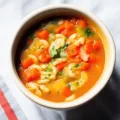Nourishing Body and Soul: The Korean New Year’s Soup Tradition
As the calendar turns to a new year, cultures around the world celebrate with unique traditions that bring families together and usher in prosperity and good fortune. In Korea, one cherished custom is the preparation and sharing of tteokguk, a hearty rice cake soup that holds deep symbolic meaning. This comforting dish not only warms the body on cold winter days but also nourishes the spirit with its connection to heritage and hope for the year ahead.
The Cultural Significance of Tteokguk
Tteokguk, which translates to “rice cake soup,” is more than just a delicious meal. In Korean culture, eating a bowl of this soup on New Year’s Day (Seollal) represents gaining a year of age and wisdom. The white color of the rice cakes symbolizes purity and new beginnings, while their round, coin-like shape represents prosperity. As family members gather to enjoy this special dish together, they’re not just satisfying their hunger – they’re participating in a ritual that strengthens bonds and honors ancestors.
A Recipe Rooted in Compassion
At its heart, the tradition of tteokguk is an expression of care and compassion. The soup is often prepared by the matriarch of the family, who pours her love and wishes for her loved ones’ wellbeing into every step of the cooking process. The sharing of the meal is a time for reflection, gratitude, and setting positive intentions for the year to come.
Here’s a simple recipe for tteokguk that you can try at home, infusing your own kitchen with this spirit of compassion:
- 8 cups of beef or vegetable broth
- 1 pound of sliced rice cakes
- 2 eggs, beaten
- 2 green onions, chopped
- 1 sheet of dried seaweed (gim), crumbled
- Salt and pepper to taste
- Bring the broth to a boil in a large pot.
- Add the rice cakes and simmer until they become soft and chewy (about 5-10 minutes).
- Slowly pour in the beaten eggs, stirring gently to create egg “ribbons.”
- Season with salt and pepper to taste.
- Serve in bowls, garnished with green onions and crumbled seaweed.
Embracing Mindfulness in the New Year
As you prepare and enjoy your tteokguk, consider it an opportunity for mindfulness. Pay attention to the textures and flavors, the warmth of the bowl in your hands, and the company of those around you. This simple act of presence can set the tone for a year of greater awareness and appreciation for life’s small joys.
Adapting Traditions for Modern Times
While tteokguk is traditionally made with beef broth, many families now create vegetarian or vegan versions to accommodate different dietary needs. This evolution of the recipe shows how cultural practices can adapt while still maintaining their core values of nourishment and togetherness. Whether you use a meat-based or plant-based broth, the intention behind the dish remains the same – to provide comfort and foster connection.
Sharing the Love Beyond Borders
In our interconnected world, learning about and participating in diverse cultural traditions can be a beautiful way to broaden our understanding and cultivate empathy. By making tteokguk in your own home, regardless of your background, you’re engaging in a form of cultural appreciation that can lead to greater global harmony. Consider inviting friends from different cultures to share in this tradition, creating a multicultural New Year’s celebration that honors various heritages.
FAQ: Korean New Year’s Soup
1. What does tteokguk symbolize in Korean culture?
Tteokguk symbolizes gaining a year of age and wisdom. The white rice cakes represent purity and new beginnings, while their round shape symbolizes prosperity.
2. Can I make tteokguk without meat?
Yes, you can use vegetable broth instead of beef broth to make a vegetarian version of tteokguk. The dish is very adaptable to different dietary preferences.
3. Where can I find rice cakes for tteokguk?
Rice cakes can usually be found in Asian grocery stores or in the international section of some larger supermarkets. They’re often available both fresh and frozen.
4. Is it okay to eat tteokguk on days other than New Year’s?
While tteokguk is traditionally eaten on New Year’s Day, it’s perfectly fine to enjoy it any time of the year. Many Koreans eat it as a comforting meal throughout the winter months.
5. How can I involve children in the tteokguk tradition?
Children can participate by helping to prepare ingredients, setting the table, or even making simple garnishes. It’s also a great opportunity to share stories about family history and cultural traditions.
As we welcome the New Year, let’s remember that traditions like tteokguk are not just about the food, but about the love, hope, and togetherness they represent. Whether you’re Korean or not, incorporating this heartwarming custom into your celebrations can add a layer of meaning and joy to your New Year. May your bowl of tteokguk bring you comfort, prosperity, and a year filled with compassion and wellbeing.









